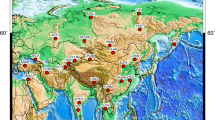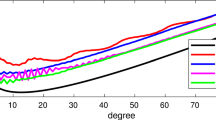Abstract
The thermal expansion effect exhibited by the GNSS monument and their nearby bedrock due to surface temperature variations is an important factor affecting the nonlinear variation of GNSS height. However, current thermal expansion models either consider only the above-surface GNSS monuments or only non-seasonal temperature variations of the subsurface bedrock, and lack a comprehensive thermal expansion model. Furthermore, previous studies on the contribution of thermal expansion effects to nonlinear variations in GNSS height have been analyzed only against one set of GNSS time series products per single research, but in fact the GNSS time series provided by each agency varied considerably. In this study, we use a refined comprehensive thermal expansion model (TEVDFSD) to evaluate its contribution to the nonlinear variations from several GNSS height products (SOPAC, JPL, and COMBINED) obtained using different data processing strategies. The results show that the most GNSS stations (about 95%) using the TEVDFSD model exhibit an annual amplitude increase and phase lag, with an amplitude increase of up to 0.5 mm and phase lag of up to 13° compared with the finite element model, especially for inland and those with deeper GNSS monument stations. This phase lag improves its correlation with the GNSS height, which reduces the GNSS height value to improve the geophysical interpretation. The TEVDFSD model estimates an annual amplitude of up to 7.5 mm, explaining at most 13.6% of the nonlinear variation in the COMBINED height. The COMBINED product exhibits a further WRMS reduction of up to 20% and 18.7% compared with the SOPAC and JPL products, respectively, which are likely due to the higher accuracy of the combined GNSS solution than of the independent data processing strategy. Our work indicates that differences in data processing strategies for GNSS height time series products significantly affect the interpretability of thermal expansion effects to nonlinear variations.


















Similar content being viewed by others
Data availability
The NCEP/NCAR reanalysis data set is available at https://www.esrl.noaa.gov/psd/data/gridded/data.ncep.reanalysis.html, the GNSS time series are available at http://garner.ucsd.edu/pub/measuresESESES_products/Timeseries/—username: anonymous; password: your email address, the ESMGFZ mass loads products for NTAL, NTOL, and HYDL datasets in CF reference frame are available at http://rz-vm115.gfz-potsdam.de:8080/repository, and the above-surface and the subsurface monument depth information are available at http://sopac-csrc.ucsd.edu/index.php/sitelogs/.
References
Biot MA (1956) Thermoelasticity and irreversible thermodynamics. J Appl Phys 27:240–253
Berger J (1975) A note on thermoelastic strains and tilts. J Geophys Res 80(2):274–277
Bock Y, Moore A, Fang P, Knox A, Sullivan A, Jiang S, Guns K, Golriz D (2019) Extended solid earth science ESDR system-algorithm theoretical basis document. State of California: Scripps Institution of Oceanography & Jet Propulsion Laboratory
Carmichael RS (1988) Practical handbook of physical properties of rocks and minerals. CRC Press, Boca Raton, FL
Clarke PJ, Lavallée DA, Blewitt G, van Dam TM, Wahr JM (2005) Effect of gravitational consistency and mass conservation on seasonal surface mass loading models. Geophys Res Lett 32(L08306).
Deng L, Jiang W, Li Z, Chen H, Wang K, Ma Y (2017) Assessment of second-and third-order ionospheric effects on regional networks: case study in China with longer CMONOC GPS coordinate time series. J Geodesy 91(2):207–227
Dong D, Fang P, Bock Y, Cheng MK, Miyazaki SI (2002) Anatomy of apparent seasonal variations from GPS-derived site position time series. J Geophys Res 107(B4):ETG-9
Fang M, Dong D, Hager H (2014) Displacements due to surface temperature variation on a uniform elastic sphere with its centre of mass stationary. Geophys J Int 196:194–203
Jiang W, Li Z, van Dam T, Ding W (2013) Comparative analysis of different environmental loading methods and their impacts on the GPS height time series. J Geodesy 87(7):687–703
Jiang W, Wang K, Deng L, Li Z (2015) Impact on non-linear vertical variation of GNSS reference stations caused by thermal expansion. Acta Geodaetica Et Cartographica Sinica 44(5):473–480
Lei J, Chen W, Li Z, Li F, Zhang S (2020) A full-spectrum bedrock thermal expansion model and its impact on the global positioning system height time series. Geophys Res Lett 47(1):e2019GL086022
Li Z, Chen W, van Dam T, Rebischung P, Altamimi Z (2020) Comparative analysis of different atmospheric surface pressure models and their impacts on daily ITRF2014 GNSS residual time series. J Geodesy 94(4):1–20
Li Z, Lu R, Jiang W, Dong D, Lei J, Lu Y, Ding X, Yang K, Chen H, Chen Q (2023) A refined full-spectrum temperature-induced subsurface thermal expansion model and its contribution to the vertical displacement of global GNSS reference stations. J Geodesy (under review).
Liu B, Ma X, Xing X, Tan J, Peng W, Zhang L (2022) Quantitative evaluation of environmental loading products and thermal expansion effect for correcting GNSS vertical coordinate time series in Taiwan. Remote Sens 14(18):4480
Nordman M (2010) Improving GPS time series for geodynamic studies. Academic Dissertation in Geophysics, Kirkkonummi
Pearson W (1966) Estimation of a correlation coefficient from an uncertainty measure. Psychometrika 31(3):421–433
Penna NT, Stewart MP (2003) Aliased tidal signatures in continuous GPS height time series. Geophys Res Lett 30(23):2184
Petit G, Luzum B (2010) IERS conventions. In: Verlag des Bundesamts für Kartographie und Geodäsie: Frankfurt am Main, Germany
Prawirodirdjo L, Ben-Zion Y, Bock Y (2006) Observation and modeling of thermoelastic strain in southern California integrated GPS network daily position time series. J Geophys Res 111:B02408
Romagnoli C, Zerbini S, Lago L, Richter B, Simon D, Domenichini F, Elmi C, Ghirotti M (2003) Influence of soil consolidation and thermal expansion effects on height and gravity variations. J Geodyn 35(4–5):521–539
Segall P, Lu S (2015) Injection-induced seismicity: Poroelastic and earthquake nucleation effects. J Geophys Res Solid Earth 120(7):5082–5103
Sośnica K, Thaller D, Dach R, Jäggi A, Beutler G (2013) Impact of loading displacements on SLR-derived parameters and on the consistency between GNSS and SLR results. J Geodesy 87(8):751–769
Tsai VC (2011) A model for seasonal changes in GPS positions and seismic wave speeds due to thermoelastic and hydrologic variations. J Geophys Res 116:B04404
Wang K, Chen H, Jiang W, Li Z, Ma Y, Deng L (2017) Improved vertical displacements induced by a refined thermal expansion model and its quantitative analysis in GPS height time series. J Geophys Eng 15(2):554–567
Xi D, Xu S (2012) Fundamentals of rock physics. University of Science and Technology of China Press.
Xu X, Dong D, Fang M, Zhou Y, Wei N, Zhou F (2017) Contributions of thermoelastic deformation to seasonal variations in GPS station position. GPS Solut 21(3):1265–1274
Yan H, Chen W, Shu Y, Zhang W, Zhong M, Liu G (2010) Thermal effects on vertical displacement of GPS stations in China. Chin J Geophys 53(4):825–832 (in Chinese)
Yan H, Chen W, Zhu Y, Zhang W, Zhong M (2009) Contributions of thermal expansion of monuments and nearby bedrock to observed GPS height changes. Geophys Res Lett, 36.
Zou R, Freymueller JT, Ding K, Yang S, Wang Q (2014) Evaluating seasonal loading models and their impact on global and regional reference frame alignment. J Geophys Res Solid Earth 119(2):1337–1358
Acknowledgements
This work is sponsored by the National Natural Science Foundation of China (Nos. 42174030, 42004017), the Special Fund of Hubei Luojia Laboratory (Nos. 220100020, 220100048), and the Hubei Provincial Science and Technology Innovation Talents (Nos. 2022EJD010).
Author information
Authors and Affiliations
Contributions
RL and ZL proposed the initial idea, designed the experiments, developed the software, and wrote the manuscript. XD, KY and MZ conducted the experiments and reviewed the manuscript. QC and HC gave some advices and revised the manuscript. YL and WF helped the visualization. WJ supervised the study and modified the manuscript. All authors approved of the manuscript.
Corresponding author
Ethics declarations
Conflict of interest
The authors declare that they have no known competing financial interests or personal relationships that could have appeared to influence the work reported in this paper.
Additional information
Publisher's Note
Springer Nature remains neutral with regard to jurisdictional claims in published maps and institutional affiliations.
Appendix A: Refined comprehensive thermal expansion model
Appendix A: Refined comprehensive thermal expansion model
In this study, we consider that the temperature of the above-surface GNSS monuments is the same as the surface temperature. The vertical displacement of the above-surface monuments due to thermal expansion effects is (Yan et al. 2009, 2010):
where \(\alpha\) is the coefficient of thermal expansion of GNSS monument; \(L\) is the height of the GNSS monument above-surface; \(T(t)\) is the surface temperature (°C) of the station at time t; \({T}^{\mathrm{^{\prime}}}\) is the average surface temperature (°C).
The surface temperature conducts heat to the subsurface bedrock by heat transfer, causing temperature changes in the subsurface monument and the bedrock (Yan et al. 2009, 2010):
where \(k\) represents the thermal diffusivity; \(y\) is the underground depth; \(t\) is the time; \(N\) is the number of decomposed harmonics of the surface temperature; \({A}_{{\text{i}}}\), \({w}_{{\text{i}}}\), and \({\mathrm{\varphi }}_{{\text{i}}}\) are the amplitude, angular frequency, and initial phase of the ith harmonic, respectively.
The thermal stress \(\upvarepsilon\) is expressed as (Dong et al. 2002):
where \(v\) denotes the Poisson’s ratio. Other symbols are the same as in (A2).
We assume that the temperature subsurface varies with depth. The temperature is the same at the same depth. The subsurface monument is a fixed-shape rigid body and its temperature varies with depth, so we use the thermoelastic deformation modeling of a fixed-shape rigid body to estimate its thermal expansion effects (Li et al. 2023).
Combining the boundary conditions (\(0<y<z\)), the heat conduction equation, and the thermal stress equation, the thermal expansion-induced vertical displacement of the subsurface monument estimated by the thermoelastic deformation modeling of a fixed-shape rigid body is derived as:
where \({v}_{1}\), \({\alpha }_{1}\), and \({k}_{1}\) are the Poisson’s ratio, coefficient of thermal expansion, and thermal diffusivity of the subsurface monument, respectively; \(z\) is the depth of the subsurface monument.
By integrating the thermal stress below the bedrock surface (\(y\ge z\)), the bedrock thermal expansion vertical displacement can be obtained, expressed as:
where \({v}_{2}\), \({\alpha }_{2}\), and \({k}_{2}\) are the Poisson’s ratio, coefficient of thermal expansion, and thermal diffusivity of the bedrock, respectively.
The comprehensive thermal expansion vertical displacement \({\Delta h}_{{{\text{TEVD}}}_{{\text{FSD}}}}\) is expressed as:
where \(\Delta {h}_{{\text{obse}}\_{\text{up}}}\), \({\Delta h}_{{\text{obse}}\_{\text{down}}}\), and \({\Delta {h}}_{{\text{bedrock}}}\) denote the thermal expansion vertical displacements of the above-surface and the subsurface monument as well as their nearby bedrock, respectively.
Rights and permissions
Springer Nature or its licensor (e.g. a society or other partner) holds exclusive rights to this article under a publishing agreement with the author(s) or other rightsholder(s); author self-archiving of the accepted manuscript version of this article is solely governed by the terms of such publishing agreement and applicable law.
About this article
Cite this article
Lu, R., Li, Z., Chen, Q. et al. On the contributions of refined thermal expansion model to nonlinear variations in different GNSS height time series products. GPS Solut 28, 80 (2024). https://doi.org/10.1007/s10291-024-01625-7
Received:
Accepted:
Published:
DOI: https://doi.org/10.1007/s10291-024-01625-7




